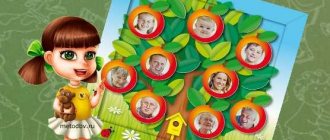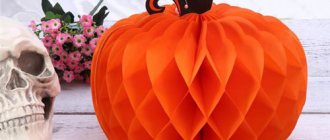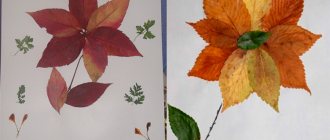Lexical topic “Forest. Trees" (1 lesson)
Transcript
1 Lexical topic “Forest. Trees" (1 lesson) Correctional educational objectives: to activate and consolidate vocabulary on the topic "Trees" (names of trees, parts of a tree); development of lexical and grammatical skills, exercise in the use of relative adjectives; development of auditory attention Corrective-developmental: improvement of the processes of perception, attention, memory, thinking, development of general, fine and facial motor skills, emotional-volitional sphere through the use of elements of psycho-gymnastics, development of fine motor skills Correctional-educational: cultivate self-control; cultivate a desire to actively work in class. Equipment computer presentation “Trees”, audio recording of forest sounds, object pictures, picture diagram “parts of a tree”, autumn leaves, leaf stencils, colored pencils Methods and techniques 1. Psycho-gymnastics - Guys, please tell me, what time of year is it now? (Autumn) - Let's imagine that we are all autumn leaves. We are all different in shape, we grew on different trees and we are all different colors and shades. And also autumn leaves can have different moods: cheerful, sad, angry. Leaves can be dreamy, enthusiastic or surprised. Let's depict the different moods of autumn leaves. — Some leaves started a fun game. Let's portray fun and joy!
2 - And others laugh at the fun game. — Someone is sad about the past summer. Let's pretend to be sad. - And someone is angry at the wind, which tore him from his native branch. — Someone was surprised when a bird sat on a branch. Let's act surprised. — Well done, guys, they perfectly conveyed the emotions of autumn leaves. 2. View the presentation “Autumn Forest”. — Guys, what did we just see on the screen? (forest, trees, autumn) - And what do you think we will talk about today? (About trees). 3. Physical exercise. We follow each other and don’t get tired at all. We raise our legs on the forest path. Left time, right time, Look at us. 4. Auditory gymnastics. Let's close our eyes and listen to the sounds of the forest. Children close their eyes and listen to the sounds of the forest. Guys, what sounds did you hear in the forest? (birds singing, leaves rustling, wind blowing) 5. Didactic game “Name the tree.” (On the board there are subject-themed pictures. Differentiation of deciduous and coniferous trees.) Everyone in the forest is surprised by the different trees growing: - Look how many different trees there are in our forest. Trees are deciduous and coniferous. - Why are deciduous trees called that?
3 - Guys, let's look at the board and name the deciduous trees. (Birch, linden, aspen, maple, poplar, willow, rowan). And now coniferous trees. (Fur tree, pine tree). 4. Consideration of the “Parts of a Tree” diagram. (picture with parts of a tree) - Let's see what a tree has, name and show the parts of the tree. (Name and show: roots, trunk, bark, branches, leaves, crown, fruits (catkins, seeds, acorns, cones, nuts, berries). 5. D/game “Which branch are the kids from?” -Guys, I have here are the fallen leaves, I will now give them to you and we will look at them and determine from which trees these leaves fell? - This leaf is from which tree? So what is it? from a birch leaf from an aspen an aspen leaf from an oak oak leaf from a linden linden leaf a maple leaf from a maple tree. 6. Finger gymnastics. “AUTUMN” The wind was flying through the forest, The wind was counting the leaves: Here is an oak leaf, Here is a maple leaf, Here is a carved rowan tree, Here is from a golden birch tree, Here is the last leaf from an aspen tree The wind threw it onto the path. 7. Stroke and coloring leaves.The speech therapist invites children to circle and color autumn leaves with colored pencils.
4 Lexical topic “Forest. Trees" (lesson 2) Correctional and educational objectives: to activate and consolidate vocabulary on the topic "Trees"; development of lexical and grammatical skills, exercise in the use of relative adjectives, coordinating them with nouns in gender, number, development of speech breathing Correctional and developmental: improvement of the processes of perception, attention, memory, thinking, development of general, fine and facial motor skills, emotional-volitional sphere through use of elements of psycho-gymnastics, correctional and educational: to cultivate self-control; cultivate a desire to actively work in class. Equipment subject pictures, autumn leaves, a letter from Lesovichka, a picture depicting fruits and animals; album 1 N.E. Teremkov p.14, cones, poster “Rules of conduct in the forest” Methods and techniques 1. Conversation. Hello guys, we have received a letter. It is written by Lesovichok. Let's read what it says. “Dear guys, hello! I am Lesovichok, the guardian of the forest. I protect the forest from people who do not value or protect the forest. They leave garbage, burn fires, cut down and break trees and bushes. I really hope you won't do this. After all, we cannot live without forests, without trees. Remember this! Please treat the forest with care!” - Guys, tell me, what is a forest?
5 A forest is a place where many trees grow. The forest, guys, is the wealth of our Motherland, Russia. The forest, so beautiful and elegant at all times of the year, gives everyone around fresh and clean air, rich in oxygen, which is so necessary for people and animals. The forest is home to animals and birds. The fruits of different trees feed animals and birds. Today we will go to the forest. 2.Guess the riddles. Guys, we know that there are many trees growing in the forest. But we will find out what trees grow in the forest when we solve the riddles. - a smooth white thin trunk with black spots, thin branches drooping down, triangular leaves (Birch). - thick trunk and branches, oval leaves, there are acorns (Oak). — the trunk is dark gray, the leaves look like an outstretched palm (Maple). — the trunk is thin, straight, brown in color, the leaf is oval in shape, consists of small leaves arranged in pairs, there are red berries (Rowan). - What are the names of all these trees (deciduous) - What other trees grow in the forest? (conifers: pine, spruce) 3. Game “One-many”, “There are many things in the forest” Birch-birch Oak oaks Pine pine Etc. There are a lot of - cones - branches - trees - stumps - needles - leaves - mushrooms - berries in the forest
6 4. Game situation “What did the forest inhabitants find” (picture depicting fruits and animals; album 1 by N.E. Teremkov p. 14) “The hedgehog found acorns. Acorns grow on oak trees,” etc. 5. Physical exercise “Autumn leaves”. - Guys, let's rest a little, get up from your seats and come here. Look here there are a lot of fallen leaves, take two leaves in one hand and the other, and repeat after me. We, the autumn leaves, sat on the branches, the wind blew and flew (blowing on the leaves) We flew, we flew and sat quietly on the ground. The wind came again and picked up all the leaves, turned them around, swirled them around and dropped them to the ground. Leaf fall! 6. Massage with the gifts of nature. Circular movements of the bump are performed between the palms and the back of the hands, accompanied by speech. You, pine cones, Give all the children Strength and health, Dexterity, beauty, Joy and fun, Intelligence and kindness!
7 7. Exercise “Related words” Where have we been? (in the forest) Who sent us the letter? (forest boy) What is the affectionate name for the forest? (wood) Who keeps order in the forest? (forester) What do you call the inhabitants of the forest, what are they? (forest) 10. Rules of behavior in the forest. Do you know how to behave in the forest? 1.Don't destroy birds' nests. 2. Don't make noise in the forest. 3.Do not light fires in the forest. 4.Do not leave garbage in the forest.


